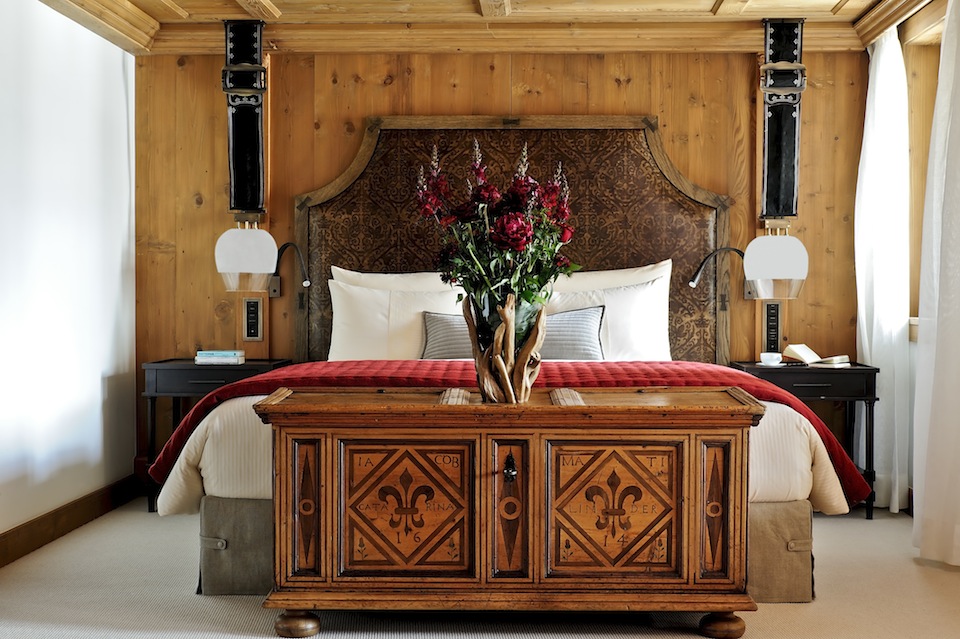
I don’t like cold, I don’t like snow, and I see little point in skiing. So, one would think that Switzerland would not rank high on my list of vacation choices. And yet, I love mountains, I think cowbells are sweet, and I even have a for soft spot for Cuckoo clocks.
Just not in winter.
So that is why I found myself in Gstaad, the luxurious ski town—but in June. If you’re not up on your history of the rich and famous, Gstaad (pronounced, “Shtaahd,” with a silent G), was the stomping ground of Princess Grace and Prince Rainier, and Elizabeth Taylor and Richard Burton in the 1960s. It also catered to the offspring of the super-rich, who attending illustrious boarding schools like Le Rosey. Later on, folks like Michael Jackson, Princess Diana, Russian oligarchs, and European royalty joined in on the winter fun. Madonna famously vacations there.
Up until 2012, well-heeled visitors typically stayed in the high-end Gstaad Palace. But that December saw the emergence of the $337 million Alpina Gstaad, the first 5-star hotel to debut in the Swiss alpine village in 100 years. The 56-room hotel, which boasts 11 apartments and three luxury chalets, is sleek and zippy, a modern interpretation of traditional Swiss architecture. Instead of Heidi ambling down the stairs, you’re more likely to see James Bond (in either Connery, Brosnan, or Craig form). The hotel’s structure is crafted from limestone and weathered barn wood. The coolest part is check-in: guests drive through a tunnel carved underground. This is good in case of, say, a blizzard, so your Louis Vuitton steamer trunks won’t get wet.
The hotel’s structure is crafted from limestone and weathered barn wood. The coolest part is check-in: guests drive through a tunnel carved underground. This is good in case of, say, a blizzard, so your Louis Vuitton steamer trunks won’t get wet.
There’s a private cinema (when I was there last summer, we watched the World Cup); a wine tasting room in a Havana-inspired cigar lounge; three restaurants including the first European outpost of MEGU; a traditional Swiss stübli; and the Michelin-starred Restaurant Sommet, which serves contemporary cuisine. The hotel also has a pretty spectacular art collection, with works by Roy Nachum, Terence Koh, Rob Pruitt, and others.
In winter months you can ski and snowboard and do all those things people like to do in Arctic temperatures. But I spent my time hiking the neighboring mountains, which were steep and invigorating (over 7,500 feet above sea level), and indulging myself in the 21,500-square-foot Six Senses Spa. It was a wise choice.
The spa is pretty amazing, with a Himalayan rock salt room, Hammam offerings, and Jacuzzi and steam rooms. They can customize fitness programs for you, or arrange for a trainer; they even offer specialized retreats. The treatments range from the standard massages and facials (which were great), to more unique offerings like reiki, tai chi, and sophrology.
Sophrology interested me. I’d never heard of it before, but the word comes from the Greek sos (harmony), phren (consciousness) and logo (study), and it’s a mix of Eastern and Western philosophical approaches that emphasize body/mind awareness. From what I deduced, it’s basically a fancy name for guided meditation. While you sit with your eyes shut, the sophrologist talks you through a series of exercises: tightening and releasing various muscles, or pouring energy into a specific body part. Then he or she will guide you to focus on a particular subject—say, relationships, or an upcoming exam, a fear of public speaking. Benefits supposedly include reducing stress, curbing anxiety, improving concentration, and increasing motivation.
I’m not sure if it was the altitude, the fresh air, or the treatments, but I certainly felt more relaxed while I was there. I was exhausted when I arrived, but a few days and a few treatments later, I felt clearheaded and able to focus on work.
Editor’s Note: The resort is offering a variety of new programs, debuting this summer. Included are the Yogic Programs, a Silent Retreat, and Private Boot Camp. The three-night Silent Retreat’s focus is to disconnect from technology and to reconnect with yourself, while the five-night Private Boot Camp, an intense Alpine workout, includes body composition analysis, outdoor activities, water activities, Alpine training, foot acupressure, deep tissue massage, and more.